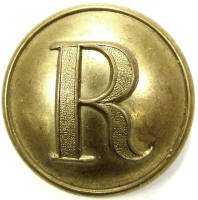
A virtual examination of artifacts of the American Civil War
 | Ridgeway Civil War Research Center,
A virtual examination of artifacts of the American Civil War |
| Civil War Artillery | |
| by Harry Ridgeway |
| Rifled artillery projectile, Broun design, Confederate manufacture, bursting projectile, short pattern with single bourrelet ring, copper band sabot, wood time fuze, Confederate rifle, 3in. Projectile was Confederate manufactured following William Broun's design. The sabot system utilized was a thin copper band sabot, notched into the base of the projectile. This pattern projectile with a rounded nose, utilized a wide bourrelet band at the top, the sabot was slightly larger than the rest of the projectile and served as a second bourrelet, as a labor saving device, only the rings had to be accurately machined, the rest could be left rough. A lathe dimple in the base, and a casting sprue on the nose are usually noted. This pattern was produced late in the war as iron was in short supply, recycled material was often used and the metal quality of these projectiles is almost always poor. Fuze employed was a wood time fuze, Jones Fuzes pg. 2, fuze hole is smooth and tapered, the simple to make fuze could easily be hammered into place. Projectile measures: diameter 2.95in., length 7.5in., excluding the fuze, weight 8 to 9lbs. Research Center: Artillery3611-Broun, Ref: Dickey & George, Field Artillery (1993 Edition), pg. 132. Details click: http://relicman.com/artillery/Artillery3611-Broun.html. |
| Civil War Relicman, Harry Ridgeway,
Civil War artillery, Relicman sales catalog. Click here for artillery for sale. artillery sales catalog. |